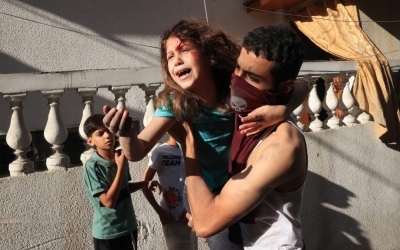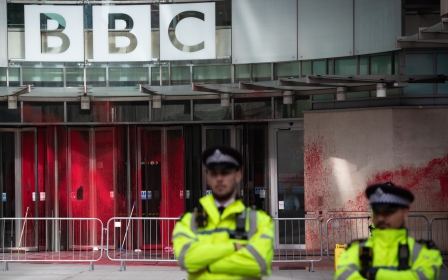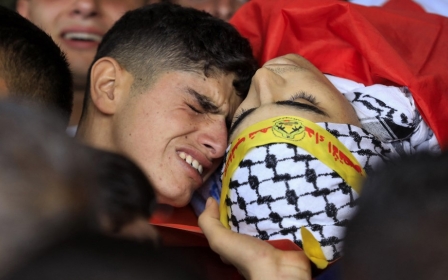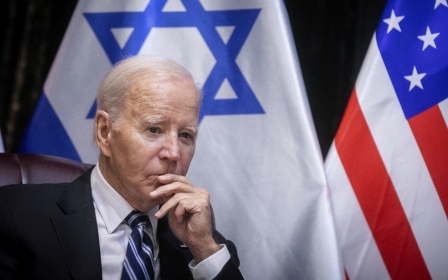Israel-Palestine war: The truth of the Gaza hospital bombing is important. It's also a distraction

The news broke as most of us were rounding off our shifts for the evening. First, a series of frenzied tweets and WhatsApp messages from the ground; then the videos began to appear.
It was hard to comprehend what was happening, but we all quickly logged back on and got to it, attempting to contact our colleagues in Gaza and Jerusalem, verify what we could, and process and blur the nightmarish footage, so it could be seen by our audience and social media content filters wouldn’t immediately flag and remove it for breaching community guidelines.
It was a near-impossible task. There were too many bodies, the screams from children and parents too much to bear, the scale too great to comprehend.
Within the first hour, we began to grasp the cataclysmic toll: hundreds of Palestinians had been killed at Al-Ahli hospital.
Some of the victims were medical staff who had refused to abandon their post, despite repeated warnings from the Israeli army. Many were victims of air strikes from previous days, who had been crushed under the rubble of their homes but miraculously survived and been rushed to the closest functioning hospital, where they awaited desperately needed attention from the overworked and traumatised staff.
But the vast majority of those at the hospital, the ones gathered in the hallways and parking lot, were people who simply did not know where else to go. They had nowhere else to take their children. They had run out of the homes they spent their lifetimes building - the places where they were born, loved and found solace - and into the congested streets of Gaza.
They had nowhere to go, but they were told to leave nonetheless. Those who decided to stay home said farewell to each other and waited for death to arrive.
Endless speculation
More than a million people have faced this choice over the past two weeks. More than 7,000 people have died in Gaza during that time, including more than 2,500 children.
In the days that followed the bombing of Al-Ahli hospital, many journalists clambered for the truth, squinting at drone footage and cross-checking maps and timelines. There was Al Jazeera footage of Hamas rockets, along with a grainy, 30-second video capturing the moment of the blast and the whistle that preceded it.
Follow Middle East Eye's live coverage for the latest on the Israel-Palestine war
There were deleted social media posts from Israeli officials; multiple media conferences; an “intercepted” phone call purportedly between Hamas fighters, who spoke forced Arabic and pointed to the wrong locations; and endless speculation about “the crater”.
All of this was combed through with the bluntest of instruments, as expert and amateur investigators tried to find solid ground while themselves being nowhere near it, then presenting imperfect deductions to a captive audience online. In the age of fake news and Midjourney, the open-source investigator was king.
It did not matter then who had done what, because the world's attention had long since shifted
First, Al Jazeera used live footage to debunk the Israeli army’s narrative that the hospital strike was the result of a misfired rocket from inside Gaza. Then the BBC chimed in, suggesting that the blast site did not align with the devastating scale of Israeli weaponry.
Next, Forensic Architecture and Al-Haq dug in, finding the projectile likely came from the north. Channel 4, the Guardian and the New York Times also weighed in, but each with the same caveat: without access to on-the-ground evidence, including ballistic fragments from the blast site, there can be no certainty.
So what was the point? Was it a noble pursuit for clarity by journalists around the world? If so, it brought no clarity, but instead created a week-long distraction from the crisis unfolding on the ground in Gaza.
Strategic disinformation
Last week, we reported on the hospital bombing too, highlighting Israel’s strategic use of disinformation during war to misdirect the attention of the media.
In August 2022, Israel denied killing five Palestinian children in an air strike on a Gaza cemetery, instead blaming an errant Islamic Jihad rocket. Everyone reported this; a week later, Israeli officials quietly admitted to Haaretz that it had, in fact, been an air strike by Israeli forces.
When journalist Shireen Abu Akleh was killed in May 2022, official Israeli army channels disseminated videos of Palestinian fighters, blaming them for her death. Months later, and after countless media exposes, it admitted culpability. It did not matter then who had done what, because the world’s attention had long since shifted.
Two weeks ago, Israeli officials exploited a misreported story about “40 beheaded babies” that filled the front pages of the tabloid media. Despite a lack of evidence, Israeli officials continued to push the story during interviews. The prime minister’s spokesperson, Tal Heinrich, told LBC: “Yes, they cut off heads, they cut off heads.” US President Joe Biden repeated this during a media conference, then his team retracted it.
All the while, Gaza was being bombed, the death toll was rising, and journalists were being sent on one futile “fact-finding mission” after another. This is not an accident; it is a PR strategy, and an effective one.
As the media circus around the hospital bombing reached a crescendo, that PR strategy kicked into high gear. Israel’s UK ambassador, Tzipi Hotovely, told Channel 4 that it was an example of Hamas “killing its own people” with rockets and that Palestinians “don’t care about human rights”. An Israeli army spokesperson published a video casting doubt on the 471 death toll, saying: “If so many people were killed, where are the bodies?”
This sent reporters down yet another rabbit hole, with some analysts questioning the reliability of casualty numbers provided by Gaza’s health ministry.
Shifting focus
Despite a general agreement about the accuracy of these numbers in the previous four wars, and despite the ministry’s figures being cited in the past by both Israel and the US, White House National Security Council spokesperson John Kirby told reporters on Tuesday: “The Ministry of Health is run by Hamas, and I think that all needs to be factored into anything that they put out publicly.”
This was repeated by Biden: “I have no notion that the Palestinians are telling the truth about how many people are killed.”
Each time reporters shift their focus away from the realities on the ground, social media buzzes, and declarative statements are made. The Israeli army is right; Hamas is right; US intelligence is right; Gaza doctors are right. Round and round it goes, and all the while, air strikes continue to decimate neighbourhoods, schools, mosques, churches, factories, houses and markets, and the death toll continues to rise - not at the hospital, but everywhere around it.
The Israeli army has not denied dropping 4,000 tonnes of explosives on Gaza before Al-Ahli hospital was bombed. In fact, it has only escalated its attacks since then, and promises to continue doing so ahead of its anticipated ground invasion. Many air raids have now hit the south, where Palestinians were told to flee to or risk being branded a “civilian shield”.
Last week, the Greek Orthodox church of St Porphyrius was bombed, killing 18 people, including a newborn baby. This week, 700 Palestinians were killed in one 24-hour window. On Wednesday, Al Jazeera’s Gaza bureau chief, Wael al-Dahdouh, lost his wife, son and daughter while reporting on-air. Did it matter to these families whether the killings took place in a hospital parking lot or a living room?
There are sometimes moments that allow reporters to be more than professional witnesses; to put down their notepads and pick up their magnifying glasses. Most journalists await those moments and spring into action when they arrive, out of a sense of duty, but also a morbid curiosity.
The danger lies not in what is found, but what is lost - and our job as journalists is not to become consumed by picking at the dry paint while losing sight of the bigger picture staring us in the face.
The views expressed in this article belong to the author and do not necessarily reflect the editorial policy of Middle East Eye.
Middle East Eye propose une couverture et une analyse indépendantes et incomparables du Moyen-Orient, de l’Afrique du Nord et d’autres régions du monde. Pour en savoir plus sur la reprise de ce contenu et les frais qui s’appliquent, veuillez remplir ce formulaire [en anglais]. Pour en savoir plus sur MEE, cliquez ici [en anglais].






